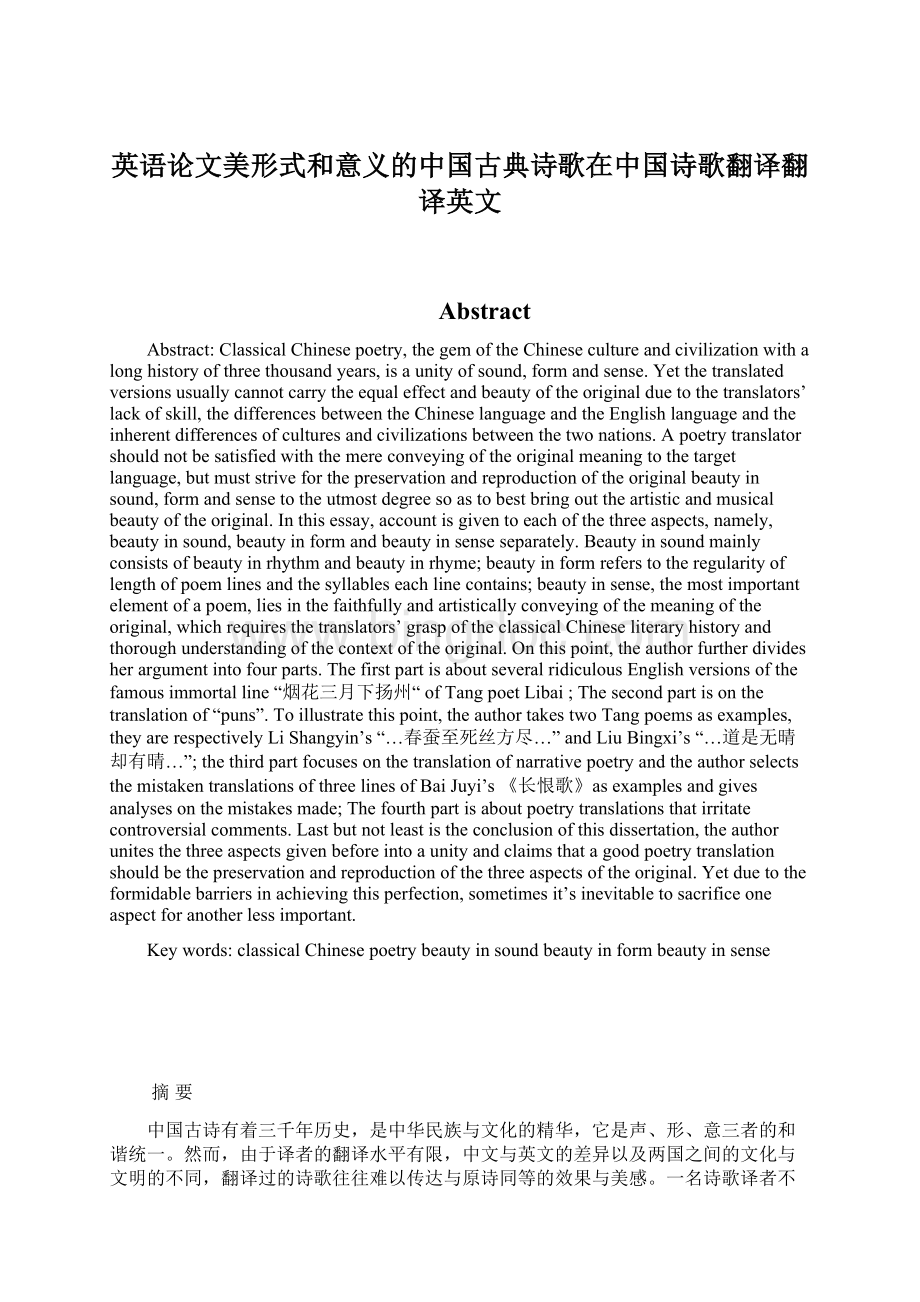英语论文美形式和意义的中国古典诗歌在中国诗歌翻译翻译英文.docx
《英语论文美形式和意义的中国古典诗歌在中国诗歌翻译翻译英文.docx》由会员分享,可在线阅读,更多相关《英语论文美形式和意义的中国古典诗歌在中国诗歌翻译翻译英文.docx(12页珍藏版)》请在冰点文库上搜索。

英语论文美形式和意义的中国古典诗歌在中国诗歌翻译翻译英文
Abstract
Abstract:
ClassicalChinesepoetry,thegemoftheChinesecultureandcivilizationwithalonghistoryofthreethousandyears,isaunityofsound,formandsense.Yetthetranslatedversionsusuallycannotcarrytheequaleffectandbeautyoftheoriginalduetothetranslators’lackofskill,thedifferencesbetweentheChineselanguageandtheEnglishlanguageandtheinherentdifferencesofculturesandcivilizationsbetweenthetwonations.Apoetrytranslatorshouldnotbesatisfiedwiththemereconveyingoftheoriginalmeaningtothetargetlanguage,butmuststriveforthepreservationandreproductionoftheoriginalbeautyinsound,formandsensetotheutmostdegreesoastobestbringouttheartisticandmusicalbeautyoftheoriginal.Inthisessay,accountisgiventoeachofthethreeaspects,namely,beautyinsound,beautyinformandbeautyinsenseseparately.Beautyinsoundmainlyconsistsofbeautyinrhythmandbeautyinrhyme;beautyinformreferstotheregularityoflengthofpoemlinesandthesyllableseachlinecontains;beautyinsense,themostimportantelementofapoem,liesinthefaithfullyandartisticallyconveyingofthemeaningoftheoriginal,whichrequiresthetranslators’graspoftheclassicalChineseliteraryhistoryandthoroughunderstandingofthecontextoftheoriginal.Onthispoint,theauthorfurtherdividesherargumentintofourparts.ThefirstpartisaboutseveralridiculousEnglishversionsofthefamousimmortalline“烟花三月下扬州“ofTangpoetLibai;Thesecondpartisonthetranslationof“puns”.Toillustratethispoint,theauthortakestwoTangpoemsasexamples,theyarerespectivelyLiShangyin’s“…春蚕至死丝方尽…”andLiuBingxi’s“…道是无晴却有晴…”;thethirdpartfocusesonthetranslationofnarrativepoetryandtheauthorselectsthemistakentranslationsofthreelinesofBaiJuyi’s《长恨歌》asexamplesandgivesanalysesonthemistakesmade;Thefourthpartisaboutpoetrytranslationsthatirritatecontroversialcomments.Lastbutnotleastistheconclusionofthisdissertation,theauthorunitesthethreeaspectsgivenbeforeintoaunityandclaimsthatagoodpoetrytranslationshouldbethepreservationandreproductionofthethreeaspectsoftheoriginal.Yetduetotheformidablebarriersinachievingthisperfection,sometimesit’sinevitabletosacrificeoneaspectforanotherlessimportant.
Keywords:
classicalChinesepoetrybeautyinsoundbeautyinformbeautyinsense
摘要
中国古诗有着三千年历史,是中华民族与文化的精华,它是声、形、意三者的和谐统一。
然而,由于译者的翻译水平有限,中文与英文的差异以及两国之间的文化与文明的不同,翻译过的诗歌往往难以传达与原诗同等的效果与美感。
一名诗歌译者不应仅仅满足于把原诗的意思完整传递到译文中,而必须尽量把原诗的音、形、意美保持与再创造到最大程度以便能最大程度地传递原诗的美感。
在本文中,作者对音美、形美、意美这三个方面分别进行了论述。
音美主要指节奏美与压韵美;形美指的是诗段的长短与每段诗句所含音节数量的规律性;意美,诗歌最重要的元素,指的是忠实并灵活地传递原诗的意思——这就要求译者对中国古代文学历史知识的掌握与对原诗上下文意思的透彻理解。
在阐释这一点上,作者把她的论据又细分为四部分:
首先,第一部分是有关李白的著名诗句“烟花三月下扬州”的几种谬译;第二部分是对“双关语”的翻译,为了分析这一点,作者举了两首唐诗作为例子这两首唐诗分别为李商隐的“……春蚕至死丝方尽……”与刘丙锡的“……道是无情却有情……”;第三部分集中在叙事诗的翻译上面,作者选择了白居易的《长恨歌》中三个诗句的谬译作为例子并对这些谬译进行了分析;第四部分是对引起争议的著名诗歌译文的剖析与见解。
最后在文章的结尾处,作者把之前论述过的三个方面结合为一体并指出一则好的诗歌译文应该是对这三者的保留与再创造。
然而,由于追求完美过程中难以逾越的障碍,有时候为了某个方面而牺牲其它比较次要的方面是难以避免的。
关键词:
中国古典诗歌音美形美意美
Beautyinsound,formandsensein
PoetryTranslation
——TranslationofClassicalChinesePoetryFrom
ChinesetoEnglish
(外语系黄晓波指导教师张宏武)
Abstract1
1.Introduction4
2.Beautyinsound5
3.Beautyinform8
4.Beautyinsense11
4.1Falsetranslationofafamousline12
4.2Translationof“puns”13
4.3Translationofnarrativepoetry15
4.4Contemporaryonpoetrytranslationthatincurredcontroversialcomments16
5.Conclusion17
References19
1.Introduction
Ithaslongbeenbelievedthatproseiswordsinbestorder;poetryisthebestwordsinthebestorder.Forme,Poetry,especiallytheclassicalChinesepoetry,notonlyhasartisticfeaturesbutalsomusicalqualitythatcombinessound,formandsenseperfectly.Chinesepoetrydisplaystousafascinatingworldofgreatenchantment,intensiveaffectionandprofoundmeaning.Inthisworld,readerscanevensmellthefreshfragranceofflowergivenofffromthesurfaceofthepoetry.Withalonghistoryofthreethousandyears,itisthegemofChinesecultureandcivilization.Sincegoodthingsneedgoodmeansofconveying,ortheywillbenothing,tomakeclassicalChinesepoetrygofartherandgetmorepopularizedintheoutsideworldcallsforgoodtranslationofit.
HowtotranslatetheChinesepoetryintoforeignlanguagewiththepreservationofitsoriginalenchantmenttothegreatestextent?
Inmyopinion,apoetrytranslatorshouldbefarfromsatisfiedwiththemereconveyingoftheideasintheoriginal,butmuststrivefortherecreationandreproductionoftheoriginalbeautyinsound,formandsense.Onlyinthisway,canatranslationversionbestbringouttheartisticandmusicalbeautyoftheoriginaltotheforeignreaders.
2.Beautyinsound
E.A.poedescribedpoetryas“music…combinedwithapleasureidea.”Li
Dongyang,afamousliterarycriticintheMingDynastyclaimedthatwhatmakespoetrydifferentfromproseisthatitpossessesregulatedsoundsandcanberecited.Similarly,Liuxie,afamousancientliterarycritic,onceallegedinhisTheLiteraryMindandtheCarvingofDragons,“Thewordswhichsettoapieceofmusicarepoetry”(李特夫、陈健景,2001).Theirremarksunanimouslyunveiledthemysteryofsound,whichendowsthepoetrywithuniquebeautyof“musicalquality”.Itisobvioustothemostuninitiatedreadersthatpoetrymakesgreateruseofthe“music”oflanguagethandoeslanguagethatisnotpoetry.
Beautyinsoundmainlyconsistsofbeautyinrhythmandbeautyinrhyme.InChineseclassicalpoetry,rhythmismainlycreatedbyobliqueandeventones,whichcanbereproducedintheEnglishversionbystressedorunstressedsyllables.Thatistosay,apoemmaybetranslatediniambics,trochaics,anapaesticsordactylics.
Asforrhymes,sinceallChineseclassicalpoemsarewritteninrhyme,noEnglishversionswithoutrhymecouldreproduceasimilareffecttotheoriginal.
CambridgeprofessorHerbertA.Gileswasamostfamoustranslatorinthe19thcentury,andthepoemscollectedinhisworkswereofhundredsofyearsago,yetreadersofhistimeweretemptedtobelievethatthesetranslatedpoemsrankedamongthebesteverknown.Giles’successwasduetothefactthathehadunitedrhymeandliteralnesswithwonderfuldexterity.
ThefollowingishistranslationofTangpoetLiBai’s《月下独酌》(DrinkAloneunderthemoon)
花间一壶酒,独酌无相亲。
举杯邀明月,对影成三人。
月既不解饮,影徒随我身。
暂伴月将影,行乐须及春。
我歌月徘徊,我舞影零乱。
醒时同交欢,醉后各分散。
永结无情游,相期邀云汉。
Anarborofflowers
andakettleofwine:
Alas!
Inthebowers
nocompanionismine.
Thenthemoonshedsherrays
onmygobletandme,
Andmyshadowbetrays
we’reapartyofthree!
Thoughthemooncannotswallow
hershareofthegrog,
Andmyshadowmustfollow
whereverIjog,
YettheirfriendshipI’llborrow
andgailycarouse,
Andlaughawaysorrow
whilespring-timeallows.
Seethemoon—howsheglances
responsetomysong;
Seemyshadow—itdances
solightlyalong!
WhilesoberIfeel,
youarebothmygoodfriends;
WhiledrunkenIreel,
ourcompanionshipends,
Butwe’llsoonhaveagreeting
withoutagoodbye,
Atournextmerrymeeting
awayinthesky.
“Flowers”inline1rhymeswith“bowers”inline2;“wine”inline3rhymeswith“mine”inline4;“rays”inline5rhymes“betrays”inline7…Inthisway,GileswassuccessfulinkeepingtheEnglishversionrhymedtoreproducebeautyinsound.
Tofurtherillustratetheimportanceandsignificanceofbeautyinsound,let’scomparethreedifferenttranslationversionsofLiBai’s《静夜思》(NightThoughts).
床前明月光,疑是地上霜。
举头望明月,低头思故乡。
(1)Idescrybrightmoonlightinfrontofmybed.
Isuspectittobehoaryfrostonthefloor.
Iwatchthebrightmoon,asItiltbackmyhead.
Iyean,whilestooping,formyhomelandmore.
——byXuZhongjie.
(2)Abed,Iseeasilverlight,
Iwonderifit’sfrostaground.
Lookingup,Ifindthemoonbright;
Browing,inhomesicknessI’mdrowned.
——byXuYuanchong.
(3)Sobrightagleamonthefootofmybed—
Couldtherehavebeenafrostalready?
Liftingmyheadtolook,Ifoundthatitwasmoonlight.
Sinkingbackagain,Ithoughtsuddenlyofhome.
——byTr.WritterBynner
Althoughthosethreeversionsareallconsideredgood,thefirstandthesecondversionsarebetterinsound.Inthefirsttwoversions,line1rhymeswithline3;line2rhymeswithline4.Bycontrast,thethirdoneisnotrhymed.Sofarasthebeautyinsoundisconcerned,itisobviousthatthefirsttwoversionsarebetterfortheypossessbeautiful“musicalquality”whenread.Musicalqualityistheuniquecharacteristicofpoetrymakingitdistinguishedfromotherliteraryforms.Inaddition,comparedtothefirst,thesecondisnotonlyrhymed,butalsosuccinctinwords,whichmakesitsoundliketheChineseregulatedverse,whilethefirstusestoomany“I”s,whichmakeitsoundalittleclumsy.
3.Beautyinform
Whilelisteningtomusic,theaudience,withoutathoroughunderstandingofthecomposer’strueimplication,maystillbemoveddeeply,Soisthecasewithclassicalpoetry.Somegoodpoems,inmanycases,havenotbeencomprehended,butthey,duetotheartisticcharminform,havealwaysbeenspokenhighlyof.Beautyinformendowspoetry,orrather,classicalChinesepoetrywithmusicalqualityandplaysakeyroleinmakingthemwidelyappreciatedovergenerations.ZhuGuangqian,anaestheteoncesaidinTheTheoryofPoetry,“Formisthesoulofpoetry.”(朱娥,2001).Poetry,especiallyclassicalChinesepoetry,isstrictwithform.It’sbetterforaversetranslatortoresemblehisversiontopreservethebeautyoftheoriginalinform,whichlieschieflyinlinelengthandparallelism.
AgainlookintoGiles’